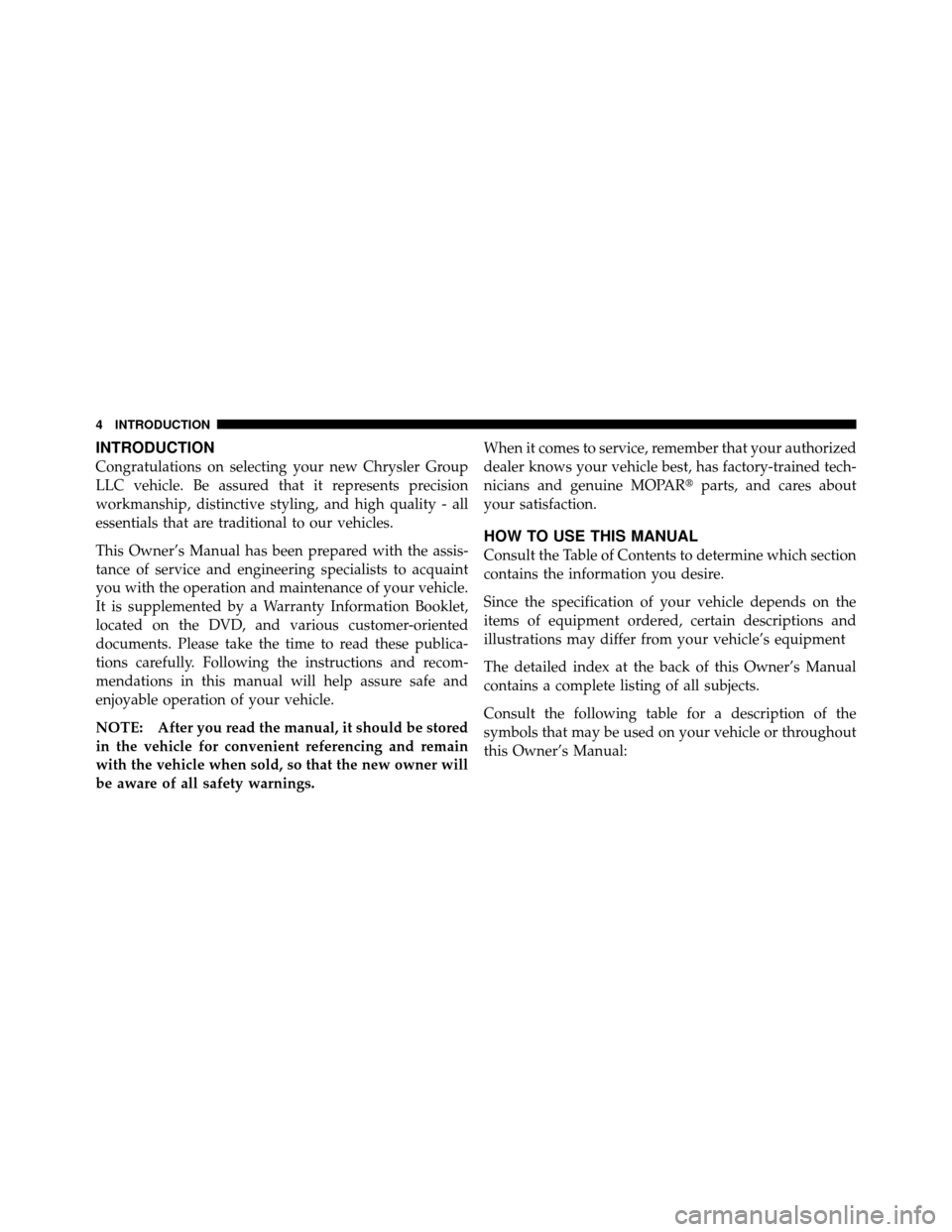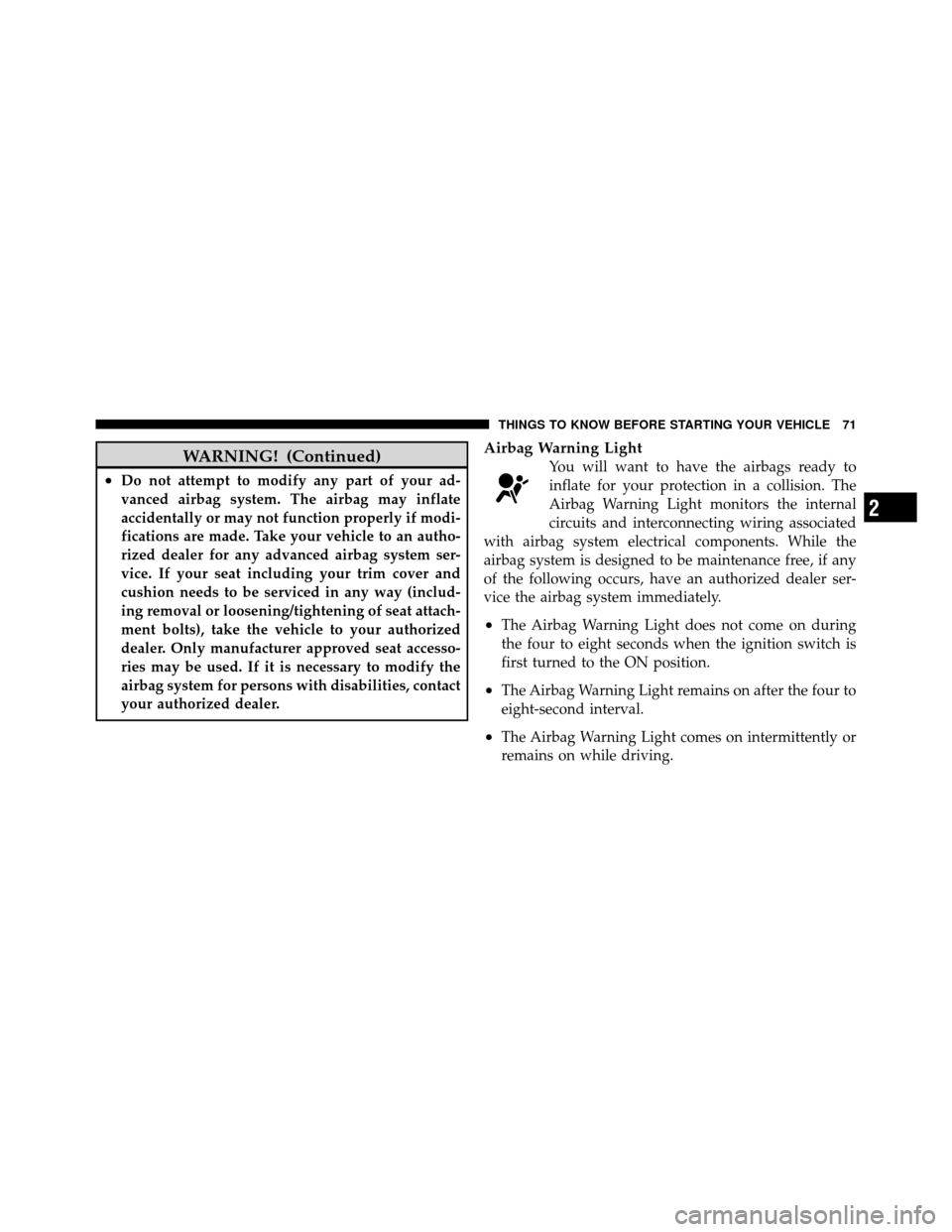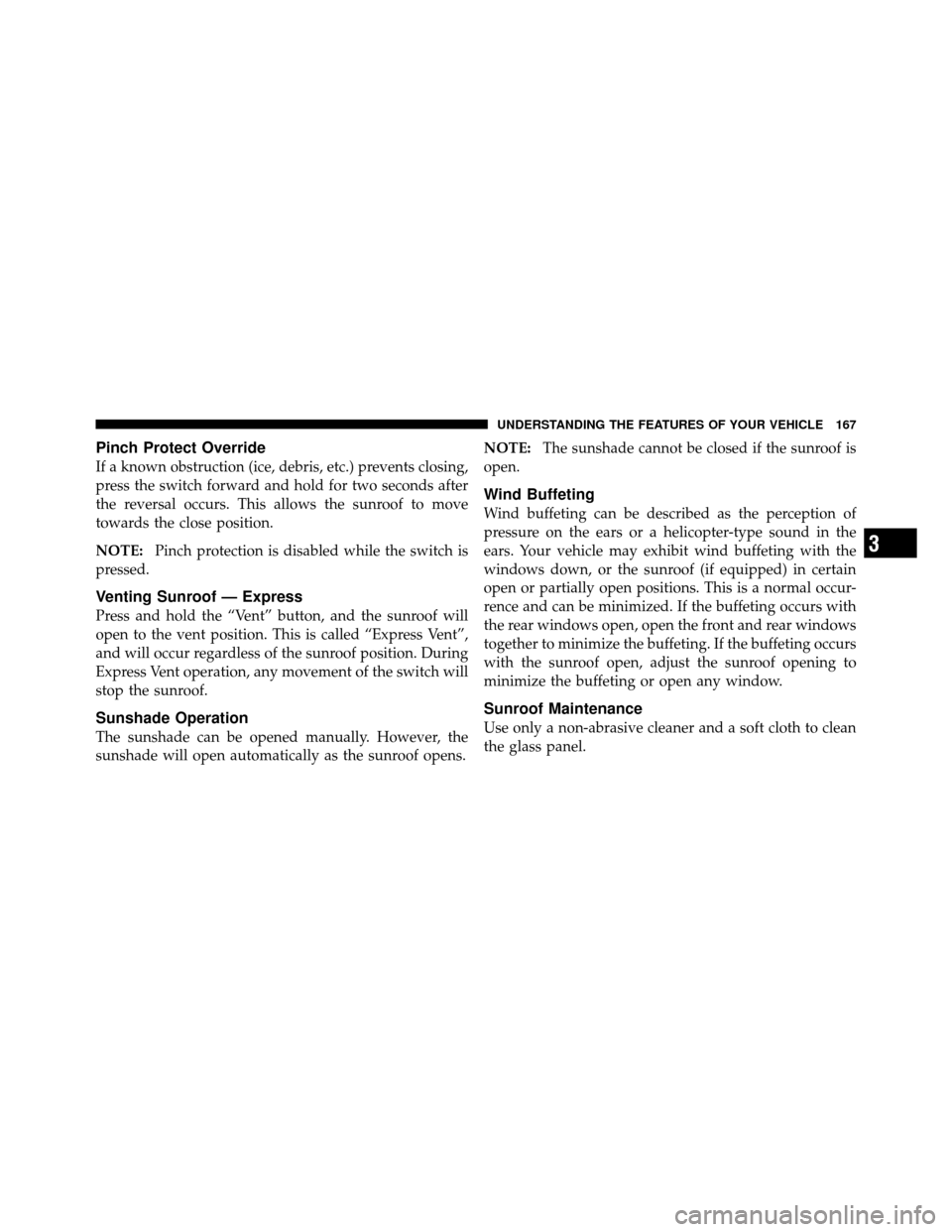Page 2 of 484
TABLE OF CONTENTSSECTIONPAGE
1INTRODUCTION............................................................3
2THINGS TO KNOW BEFORE STARTING YOUR VEHICLE..............................9
3UNDERSTANDING THE FEATURES OF YOUR VEHICLE............................. 91
4UNDERSTANDING YOUR INSTRUMENT PANEL.................................. 185
5STARTING AND OPERATING................................................289
6WHAT TO DO IN EMERGENCIES............................................. 371
7MAINTAINING YOUR VEHICLE..............................................389
8MAINTENANCE SCHEDULES.................................................437
9IF YOU NEED CONSUMER ASSISTANCE........................................ 455
10INDEX...................................................................465
1
2
3
4
5
6
7
8
9
10
Page 5 of 484

INTRODUCTION
Congratulations on selecting your new Chrysler Group
LLC vehicle. Be assured that it represents precision
workmanship, distinctive styling, and high quality - all
essentials that are traditional to our vehicles.
This Owner’s Manual has been prepared with the assis-
tance of service and engineering specialists to acquaint
you with the operation and maintenance of your vehicle.
It is supplemented by a Warranty Information Booklet,
located on the DVD, and various customer-oriented
documents. Please take the time to read these publica-
tions carefully. Following the instructions and recom-
mendations in this manual will help assure safe and
enjoyable operation of your vehicle.
NOTE: After you read the manual, it should be stored
in the vehicle for convenient referencing and remain
with the vehicle when sold, so that the new owner will
be aware of all safety warnings.When it comes to service, remember that your authorized
dealer knows your vehicle best, has factory-trained tech-
nicians and genuine MOPAR�
parts, and cares about
your satisfaction.
HOW TO USE THIS MANUAL
Consult the Table of Contents to determine which section
contains the information you desire.
Since the specification of your vehicle depends on the
items of equipment ordered, certain descriptions and
illustrations may differ from your vehicle’s equipment
The detailed index at the back of this Owner’s Manual
contains a complete listing of all subjects.
Consult the following table for a description of the
symbols that may be used on your vehicle or throughout
this Owner’s Manual:
4 INTRODUCTION
Page 15 of 484

CAUTION!
An unlocked car is an invitation to thieves. Always
remove the key from the ignition and lock all the
doors when leaving the vehicle unattended.
Locking Doors With A Key
You can insert the key with either side up. To lock the
door, turn the key to the right. To unlock the door, turn
the key to the left. Refer to “Maintenance Procedures” in
“Maintaining Your Vehicle” for further information.
Key-In-Ignition Reminder
Opening the driver’s door when the key is in the ignition
and the ignition position is LOCK or ACC, sounds a
signal to remind you to remove the key.
NOTE:With the driver’s door open and the key in the
ignition, the power door locks will not lock and Remote
Keyless Entry (RKE) transmitter will not function.
SENTRY KEY�
The Sentry Key� Immobilizer System prevents unautho-
rized vehicle operation by disabling the engine. The
system does not need to be armed or activated. Operation
is automatic, regardless of whether the vehicle is locked
or unlocked.
The system uses ignition keys that have an embedded
electronic chip (transponder) to prevent unauthorized
vehicle operation. Therefore, only keys that are pro-
grammed to the vehicle can be used to start and operate
the vehicle. The system will shut the engine off in two
seconds if someone uses an invalid key to try to start the
engine.
NOTE: A key that has not been programmed is also
considered an invalid key, even if it is cut to fit the
ignition switch lock cylinder for that vehicle.
During normal operation, after turning on the ignition
switch, the Vehicle Security Light will turn on for three
14 THINGS TO KNOW BEFORE STARTING YOUR VEHICLE
Page 72 of 484

WARNING! (Continued)
•Do not attempt to modify any part of your ad-
vanced airbag system. The airbag may inflate
accidentally or may not function properly if modi-
fications are made. Take your vehicle to an autho-
rized dealer for any advanced airbag system ser-
vice. If your seat including your trim cover and
cushion needs to be serviced in any way (includ-
ing removal or loosening/tightening of seat attach-
ment bolts), take the vehicle to your authorized
dealer. Only manufacturer approved seat accesso-
ries may be used. If it is necessary to modify the
airbag system for persons with disabilities, contact
your authorized dealer.
Airbag Warning Light
You will want to have the airbags ready to
inflate for your protection in a collision. The
Airbag Warning Light monitors the internal
circuits and interconnecting wiring associated
with airbag system electrical components. While the
airbag system is designed to be maintenance free, if any
of the following occurs, have an authorized dealer ser-
vice the airbag system immediately.
•The Airbag Warning Light does not come on during
the four to eight seconds when the ignition switch is
first turned to the ON position.
•The Airbag Warning Light remains on after the four to
eight-second interval.
•The Airbag Warning Light comes on intermittently or
remains on while driving.
2
THINGS TO KNOW BEFORE STARTING YOUR VEHICLE 71
Page 86 of 484

The engine oil installed in the engine at the factory is a
high-quality energy conserving type lubricant. Oil
changes should be consistent with anticipated climate
conditions under which vehicle operations will occur. For
the recommended viscosity and quality grades refer to
“Maintenance Procedures” in “Maintaining Your Ve-
hicle”. NON-DETERGENT OR STRAIGHT MINERAL
OILS MUST NEVER BE USED.
A new engine may consume some oil during its first few
thousand miles (kilometers) of operation. This should be
considered a normal part of the break-in and not inter-
preted as an indication of difficulty.
SAFETY TIPS
Transporting Passengers
NEVER TRANSPORT PASSENGERS IN THE CARGO
AREA.
WARNING!
•Do not leave children or animals inside parked
vehicles in hot weather. Interior heat build-up may
cause serious injury or death.
•It is extremely dangerous to ride in a cargo area,
inside or outside of a vehicle. In a collision, people
riding in these areas are more likely to be seri-
ously injured or killed.
•Do not allow people to ride in any area of your
vehicle that is not equipped with seats and seat
belts.
•Be sure everyone in your vehicle is in a seat and
using a seat belt properly.
2
THINGS TO KNOW BEFORE STARTING YOUR VEHICLE 85
Page 95 of 484

▫Wind Buffeting ...................... 167
▫ Sunroof Maintenance ................. 167
▫ Ignition Off Operation ................. 168
� Electrical Power Outlets ................. 168
� Power Inverter — If Equipped ............ 170
� Cupholders .......................... 172
� Storage ............................. 173
▫ Glove Compartment And Storage Bin ...... 173
▫ Upper Instrument Panel Storage .......... 173
▫ Door Storage — If Equipped ............ 174
� Chill Zone� Beverage Cooler Storage
Compartment — If Equipped .............. 175�
Console Features ...................... 176
� Cargo Area Features ................... 178
▫ Cargo Light/Removable Self-Recharging
Flashlight .......................... 178
▫ Cargo Cover ........................ 179
▫ Removable Load Floor ................ 181
▫ Cargo Tie-Down Loops ................ 181
▫ Fold Down Speakers — If Equipped ....... 182
� Rear Window Features .................. 183
▫ Rear Window Wiper/Washer ............ 183
▫ Rear Window Defroster ................ 184
94 UNDERSTANDING THE FEATURES OF YOUR VEHICLE
Page 168 of 484

Pinch Protect Override
If a known obstruction (ice, debris, etc.) prevents closing,
press the switch forward and hold for two seconds after
the reversal occurs. This allows the sunroof to move
towards the close position.
NOTE:Pinch protection is disabled while the switch is
pressed.
Venting Sunroof — Express
Press and hold the “Vent” button, and the sunroof will
open to the vent position. This is called “Express Vent”,
and will occur regardless of the sunroof position. During
Express Vent operation, any movement of the switch will
stop the sunroof.
Sunshade Operation
The sunshade can be opened manually. However, the
sunshade will open automatically as the sunroof opens. NOTE:
The sunshade cannot be closed if the sunroof is
open.
Wind Buffeting
Wind buffeting can be described as the perception of
pressure on the ears or a helicopter-type sound in the
ears. Your vehicle may exhibit wind buffeting with the
windows down, or the sunroof (if equipped) in certain
open or partially open positions. This is a normal occur-
rence and can be minimized. If the buffeting occurs with
the rear windows open, open the front and rear windows
together to minimize the buffeting. If the buffeting occurs
with the sunroof open, adjust the sunroof opening to
minimize the buffeting or open any window.
Sunroof Maintenance
Use only a non-abrasive cleaner and a soft cloth to clean
the glass panel.
3
UNDERSTANDING THE FEATURES OF YOUR VEHICLE 167
Page 189 of 484
▫Operating Instructions — Video
Entertainment System (VES)™
(If Equipped) ....................... 273
� Remote Sound System Controls —
If Equipped .......................... 273
▫ Radio Operation ..................... 274
▫ CD Player ......................... 274
� CD/DVD Disc Maintenance .............. 274�
Radio Operation And Cellular Phones ....... 275
� Climate Controls ...................... 275
▫ Manual Heating And Air Conditioning ..... 276
▫ Automatic Temperature Control (ATC) —
If Equipped ........................ 280
▫ Operating Tips ...................... 285
188 UNDERSTANDING YOUR INSTRUMENT PANEL